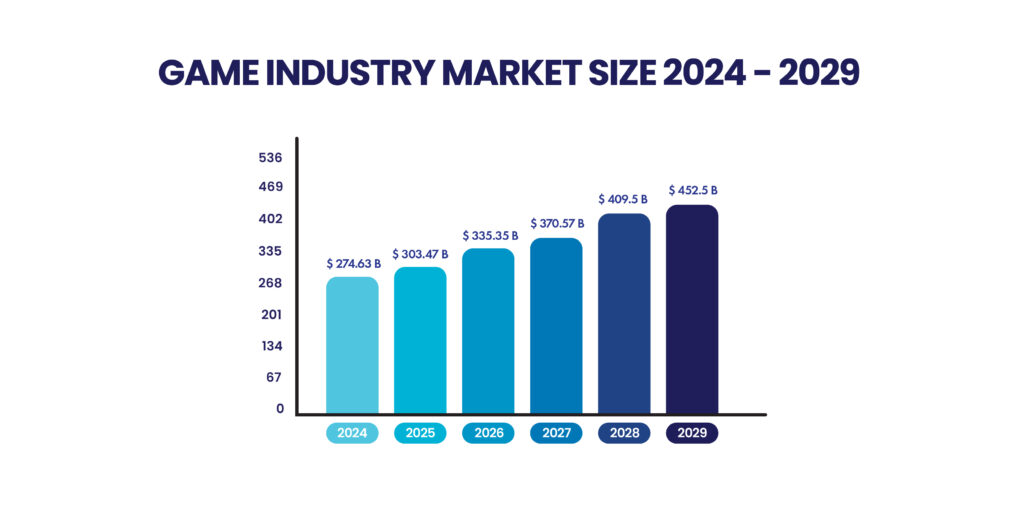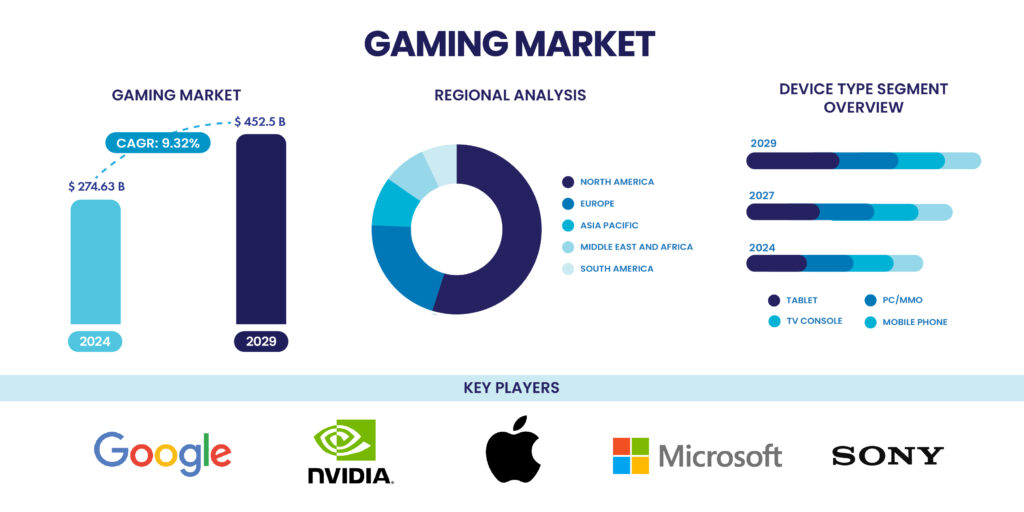The gaming industry is one of the fastest-growing parts of the entertainment sector. By showing a continuous upward trajectory in growth and revenue under critical economic fluctuations, the market has shown promising scalability and potential for constant expansion in the future. The world is conceiving improved gaming experiences propelling revenue generation in the gaming industry. …
The gaming industry is one of the fastest-growing parts of the entertainment sector. By showing a continuous upward trajectory in growth and revenue under critical economic fluctuations, the market has shown promising scalability and potential for constant expansion in the future. The world is conceiving improved gaming experiences propelling revenue generation in the gaming industry. This article delves deep into the intensive analysis of the gaming industry’s size, and market share and will explore key emerging trends according to reputable sources.
Industry Size and Market Share

Current Market Size
According to Mordor Intelligence, the global gaming market is valued at 272.86 billion USD up until 2024. Considering various segments such as mobile games, console games, PC games, and AR/VR gaming experiences, the gaming market’s momentous growth is associated with increased gaming hardware purchases and other related content. This development is also due to the increase in the use of smartphones and high-speed internet access worldwide.
Market Share Distribution
It is observed that the market share within the gaming industry is pretty diverse. With the extensive use of smartphones worldwide and tailored gaming experiences built for smartphones, mobile gaming holds the largest share. It is followed by console gaming which witnesses quite a lot of continuous innovations that drive the significant growth of the market. Companies like Sony, Microsoft, and Nintendo consistently introduce cutting-edge technologies and captivating game titles, maintaining their stronghold on dedicated gamers. While PC gaming remains popular in North America, Europe, and Asia-Pacific, AR and VR gaming, which show promising growth to hold substantial market share, are still emerging.
Growth Trends
Technological Advancements
The gaming industry leads the way in technological innovation, constantly pushing the boundaries of what’s possible. Innovations in artificial intelligence (AI), immersive technologies like AR and VR, and advanced graphic processing are the vital reasons behind the transformation of gaming experiences. The integration of AI in game development boosts the overall gameplay and player engagement by finetuning game mechanics. AR and VR technologies unlock new dimensions in improving gaming experiences by providing players with meticulously designed interactive and immersive experiences that allow the users to atone with the virtual game world.
Esports and Live Streaming
Esports or Electronic Sports is one of the notable contributors to the multiplication of the gaming industry. Countless gaming streamers are religiously followed by millions worldwide, making it a promising and lucrative career path for gamers. Major live-streaming platforms such as Twitch and YouTube Gaming have contributed to this trend by offering not only entertainment but also a community space for gamers worldwide. These platforms enable gamers to connect and engage with diverse audiences, further fueling the industry’s growth.
Mobile Gaming Expansion
Mobile gaming persists to be the fastest-growing segment in the gaming industry. As mentioned earlier, the affordability of smartphones and the development of high-quality mobile games have introduced gaming to a wider audience. Specifically, casual games which are relatively easier to play and quite often free to play with in-app purchases dominate mobile gaming. Alternatively, the development of graphically intensive and more complex mobile games that cater for the needs of hardcore gamers also witnessed a rising trend.
Market Expansion in Emerging Economies
The gaming industry is experiencing the birth of new markets as emerging economies in Asia, Latin America, and Africa come into play. With the increasing number of internet and smartphone users across these regions, this has become a vital opportunity for game developers and publishers. The surge in gamers in countries like India, Brazil, and South Africa is contributing to breaking new ground at an international level.
Forecast (2024 – 2029)

Projected Market Size
Going global, the gaming market will grow from $272.86 billion in 2024 to $426.02 billion in 2029 at a CAGR of about 9.25%. This increase can be further attributed to constant technological advancement in gaming, the increasing popularity of esports, and the mobile market growth.
Key Growth Drivers
- Technological Innovations: Attractive gaming experiences from the innovation of AI, VR, and AR will continuously grasp new players and drive engagement in user experiences.
- Esports Growth: The segment of professional gaming and esports will keep growing in terms of its audiences, becoming a significant source of revenue for the industry.
- Mobile Gaming Dominance: The development of new games for smartphones and tablets of high-quality content will favour the dominance of mobile gaming among other segments of the gaming industry.
- Growing Demographics of Gamers: The demography of gaming is becoming variegated with increased involvement from women and older age groups, thus expanding the reach of the market.
Regional Analysis
- North America: This region will continue to be one of the largest markets for the gaming industry, with console and PC gaming possessing solid contributions. And the US remains a hub for game development and innovation.
- Europe: The continent has shown growth over the years and is expected to continue, with the highest contributors projected being mobile and console gaming, especially in countries such as Germany, the UK, and France.
- Asia-Pacific: This is poised to be the region with the highest growth driven by countries such as China, Japan, and South Korea. Mobile gaming in this area will majorly be responsible for the increase.
- Latin America and Africa: Emerging markets in these regions will witness a boom in rapid growth with an increased incidence of smartphone and internet usage.
Threats
- Regulatory Issues: Regulations regarding gaming content, in-game purchase safety, and data privacy vary from country to country and are liable for threats to game developers and publishers.
- Market Saturation: Mature markets pose the challenge of market saturation to the gaming industry. The industry has to find new sources of innovation to retain and grow its players.
- Cybersecurity Threats: The platforms for gaming have been getting more connected, with the entry of cybersecurity threats associated with this.
Opportunities
- Cloud Gaming: The availability of cloud gaming services such as Google Stadia and NVIDIA GeForce Now has brought a new way to the gaming market that lets gamers stream games across different devices without hardware requirements.
- Cross-Platform Play: A trend where cross-platform play is becoming the order of the day breaks barriers between the various gaming ecosystems so that a player from any device can connect with other players adding fun to everything.
- NFTs and Blockchain: The use of blockchain technology and non-fungible tokens in gaming brings about all sorts of new possibilities for complete ownership and monetization of many different kinds of in-game assets.

Conclusion:
The game-based market will witness tremendous growth from 2024 to 2029 due to technological development, the growing popularity of esports, and the enlargement of mobile gaming. Spanning around an estimated 426.02 billion USD by the fiscal year 2029, this industry opens up even more significant opportunities for innovation and investments to flourish, but not without putting up a tough fight. The gaming industry will continuously forge a new path and diversify from there, providing people all over the world a chance to have rich and varied experiences with the opportunities that it creates.


